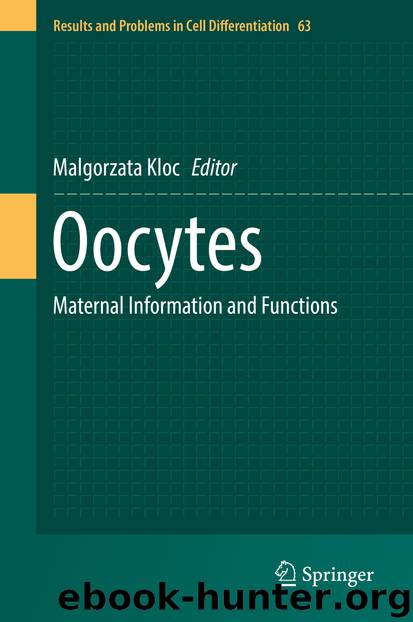Oocytes by Malgorzata Kloc

Author:Malgorzata Kloc
Language: eng
Format: epub
Publisher: Springer International Publishing, Cham
12.2.3 Subcortical Maternal Complex (SCMC)
Populations of RNA-binding proteins (RBPs) and RNAs have been identified at the subcortical region of the cytoplasmic membrane of the mammalian oocyte (Ohsugi et al. 2008; Herr et al. 2008; Li et al. 2008, 2010, 2013; Flemr et al. 2010) and are believed to play a role in mRNA storage and metabolism. Subcortical complexes share components with P-bodies (processing bodies) including several RNA-binding proteins, such as DDX6, MSY2 (YBX2), and CPEB1 (Flemr et al. 2010). Consistent with their function as a storage compartment, they detach from the cortex upon resumption of meiosis, relocate toward the center of the oocyte, and dissolve. One of the components of the SCMC is the translational repressor DDX6 (Rck/p45) which is implicated in the control of maternal mRNAs in lower organisms (Weston and Sommerville 2006). DDX6 orthologues are found in a number of different RNA granules regulating mRNA stability and translation throughout female germ cell development and in the soma (Weston and Sommerville 2006). SCMC contains MATER (mater protein homolog), together with FILIA (KH domain containing 3 like, subcortical maternal complex member), FLOPED (HOEP19, oocyte-expressed protein), peptidyl arginine deiminase 6), and TLE6 (transducin-like enhancer of split 6) proteins, and this complex has been shown to be essential for preimplantation embryo development beyond the two-cell stage. The role of the SCMC complex in mRNA metabolism is not clear, although it is known that FLOPED is a putative RNA-binding protein (Pierre et al. 2007; Herr et al. 2008; Li et al. 2008). Absence of the SCMC significantly impedes development beyond the two-cell-stage embryo, and it seems likely that defects arise earlier, since the progression from one to two cells is delayed and initial cell division is often asymmetrical. This could result from abnormalities in syngamy, mitotic spindle formation (loss of FILIA causes defects in spindle assembly), cytokinesis, or cell cycle progression and could affect later events in embryonic development including axes formation, a subject of intense investigative interest (Rossant and Tam 2004; Louvet-Vallée et al. 2005; Motosugi et al. 2005; Kurotaki et al. 2007; Bischoff et al. 2008). Downregulation of oocyte- and embryo-restricted SCMC component PADI6 shows that maternal ribosomes are not able to properly store subsets of transcripts in the cytoplasmic lattice structures, which results in a reduction of total de novo protein synthesis at the two-cell stage (Yurttas et al. 2008).
Download
This site does not store any files on its server. We only index and link to content provided by other sites. Please contact the content providers to delete copyright contents if any and email us, we'll remove relevant links or contents immediately.
Men In Love by Nancy Friday(5156)
Everything Happens for a Reason by Kate Bowler(4679)
The Immortal Life of Henrietta Lacks by Rebecca Skloot(4525)
Why We Sleep by Matthew Walker(4360)
The Sports Rules Book by Human Kinetics(4294)
Not a Diet Book by James Smith(3336)
The Emperor of All Maladies: A Biography of Cancer by Siddhartha Mukherjee(3066)
Sapiens and Homo Deus by Yuval Noah Harari(2987)
Day by Elie Wiesel(2720)
Angels in America by Tony Kushner(2596)
A Burst of Light by Audre Lorde(2546)
Endless Forms Most Beautiful by Sean B. Carroll(2431)
Hashimoto's Protocol by Izabella Wentz PharmD(2331)
Dirty Genes by Ben Lynch(2272)
Reservoir 13 by Jon McGregor(2242)
Wonder by R J Palacio(2140)
And the Band Played On by Randy Shilts(2129)
The Immune System Recovery Plan by Susan Blum(2029)
Stretching to Stay Young by Jessica Matthews(2001)
